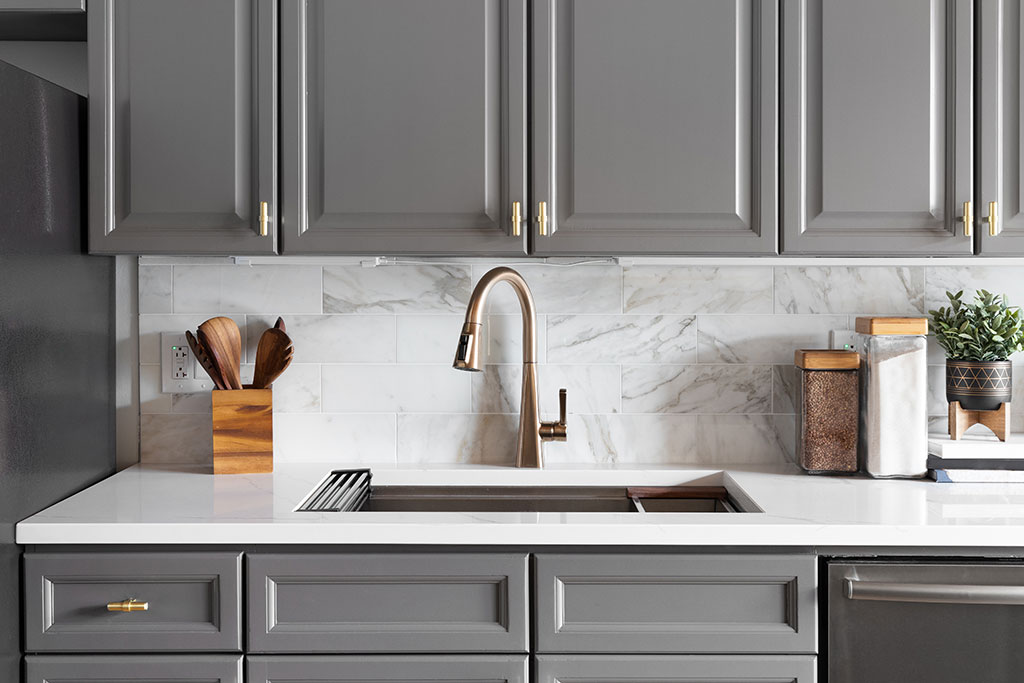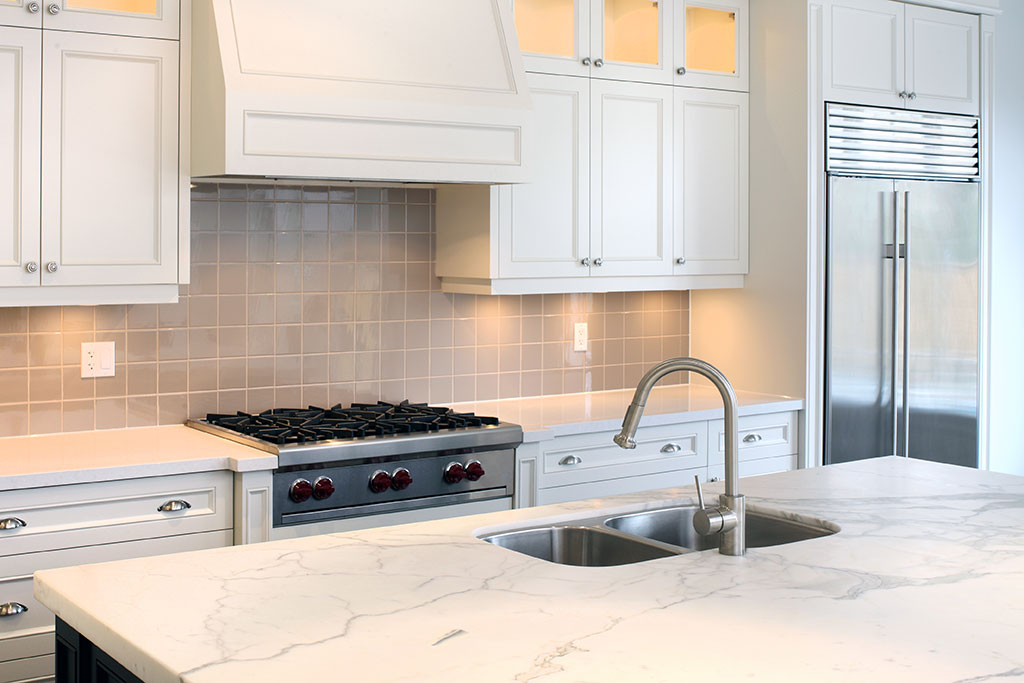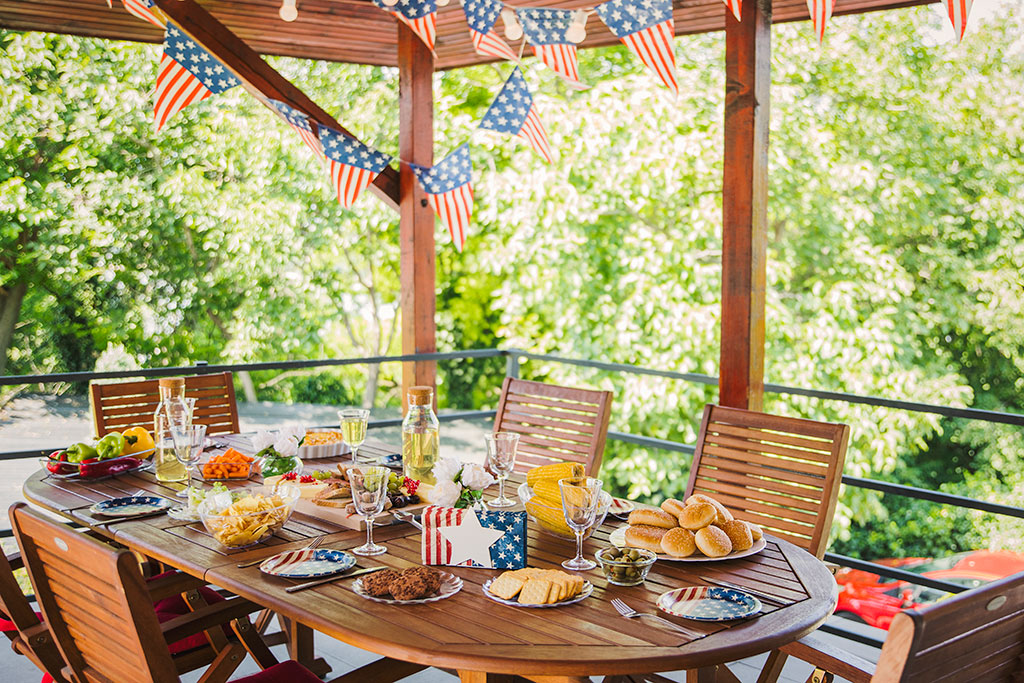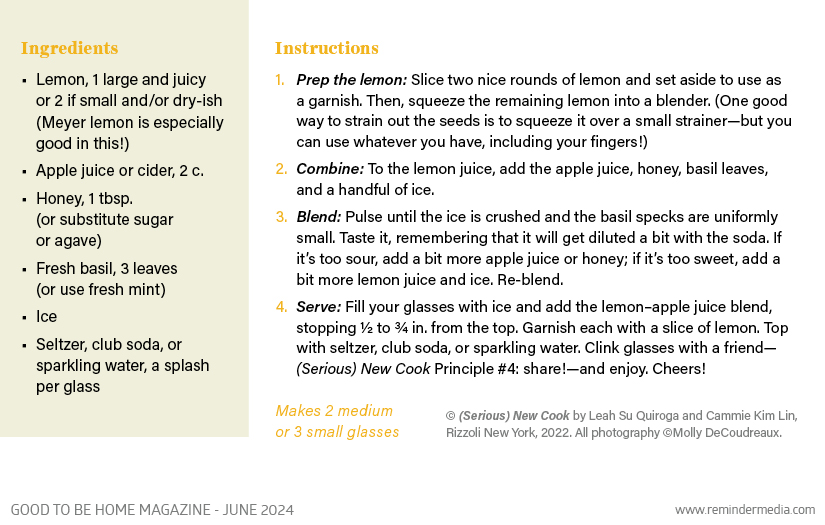Are you tired of staring at your home’s beige walls, outdated tile, or dingy countertops? If you think you need to invest in a significant renovation to revitalize them, think again—you can update their appearance by simply brushing on some paint. Consider trying one of these fun and easy projects to add extra pizzazz to your spaces.

Inject life into an otherwise neutral room by creating an accent wall. For example, you can go bold with an attention-grabbing red or create a relaxing ambience with a soothing sage green or sky blue. To determine the ideal color for a space, browse images online or in magazines for inspiration. Alternatively, pick a hue already in the room, such as from the artwork or pillows. For added visual interest, stencil a botanical, floral, or geometric pattern on the wall; you could even make it look like it’s made of brick.

Don’t forget this uppermost part of a room, often called the “fifth wall” by designers. White is a standard choice for ceilings, but it’s not the only option. Consider continuing the shade of your walls onto your ceiling or matching a tone in your wallpaper for a harmonious look. You could also make a statement by painting it celestial blue, raspberry red, or luxurious gold or even go a daring step further with a striped pattern. If your ceiling has minor surface imperfections, opt for a light-colored paint in a matte finish to avoid drawing attention to them. Cover surfaces you don’t plan to paint with tarps, and protect your eyes with goggles as you work. If you’ll also be updating the color of your walls, tackle them last so they won’t get splattered with your ceiling paint.

You can change the color of your bathroom or kitchen tile, or simply make it look new again, with a coat or two of epoxy paint; you’ll want to use one specifically made for refinishing ceramic or porcelain surfaces. Be sure to rigorously clean and sand the tiles first (per the paint’s instructions), wear protective glasses and gloves, and ventilate the area to reduce potentially harmful fumes. This project can certainly be intensive, but the beautiful new waterproof finish you’ll be left with will make the effort and precautions more than worth it.

If your cabinets are in good shape, avoid the hassle and cost of ripping them out by painting them. Whether they’re laminate or wood, the process is essentially the same: Start by removing the hardware, doors, and drawers. Then clean the cabinet surfaces with Krud Kutter, fill in any dents with wood putty, and make other necessary repairs. Once the wood putty has completely dried, lightly sand your cabinets to help the paint adhere better. Add a coat or two of primer, and follow up with a couple layers of standard semi-gloss acrylic latex paint or one especially formulated for refinishing cabinets. After the paint is dry, reinstall the doors, drawers, and hardware.

Do your laminate countertops look like they’ve seen better days? Would you prefer to replace them with stone but don’t have the funds? You can still get the aesthetic you crave at a lower cost by—you guessed it—painting them. Just make sure you’re committed to the project before moving forward since the primer and paint will be difficult to remove once they’re applied. Sand your counters first, then apply primer, two layers of a water-based acrylic paint, and an epoxy resin topcoat. You could also use an all-in-one kit, such as one that makes your countertops resemble marble or quartz; as a bonus, this option would take the guesswork out of which products to use and may include tips to guide you.

A little latex paint can completely transform your furniture, whether it’s wood, laminate, or wood veneer—simply follow the same process described above for painting cabinets. Rather than latex paint, consider using chalk paint, which is formulated to adhere well to surfaces without much prep work. For extra fun, let your creativity loose and jazz up your pieces with colorful stripes, gold accents, or a hand-painted design.

Spray paint can be used to refurbish many items in your home, including door hinges and knobs, faucets, light fixtures, and picture frames. You could even update your fireplace with the help of high-heat spray paint or your patio or deck furniture with an outdoor version. These changes may seem relatively minor, but they can give a space like your living or family room a completely new look for very little effort or cost.
Once you’re bitten by the painting bug, you may never go back—your home can become your canvas, inspiring you to transform it as you please into your ultimate dream haven.
Summer is peak season for graduations, weddings, retirements, anniversaries, and other milestone events, and that can only mean one thing: it’s time to plan a party. But rather than shell out thousands on venue rental costs, invite cherished friends and family over to your home for a familiar, comforting celebration. If you can pull off a beautiful backyard bash, you’re sure to create valuable memories for guests and honored attendees alike—while earning yourself a few gracious pats on the back too.
Of course, taking the helm of the party-planning vessel is a huge responsibility, essentially hefting an important date’s success entirely on your shoulders. Follow this hosting guide to help you prepare the basics, decorate to inspire awe, and craft an event your loved ones will both enjoy and reminisce on for years to come.

A party just isn’t a party without these celebration essentials. In fact, they are so integral to successful gatherings that people won’t merely expect them—they might send you sidelong glances if you omit them.
Invitations
Text and email invites are fitting for casual festivities, but parties feel more special when they’re announced via formal letters containing the event details. As for how early to mail these out, the Emily Post Institute suggests using the purpose of the event to determine a good time frame—for example, within four weeks for a cocktail party or up to three months in advance for a fundraiser. Check out the chart on its website for a full timing breakdown.
Seating
You’ll need a head count before the occasion to gauge how many tables and seats to provide. Once guests RSVP to your party, you can order seating or buy your own, depending on the size of the event and whether you plan to host again in the future. Arranged seating isn’t a must, but it is a good idea to group compatible guests.
Music
Curate songs or albums that suit the event’s tone and the celebrant’s tastes. You can easily build a digital playlist on a music-streaming app, then play it via Bluetooth on a set of outdoor-friendly speakers. (You could also rent audio equipment at a potentially low rate.) Just watch the volume—guests should still be able to chat comfortably over the music.
Themed decor
Without the appropriate adornments, your bash will look just like any other weekend get-together, so budget both time and money for decorating according to the event’s theme. Include a range of attractive lighting, decor like balloons and streamers, and flowers for formal affairs. For best results, meet with the guest of honor at your home at least two weeks before the event to brainstorm.
Beverages
Keep guests happy and hydrated by offering a variety of beverage options. Provide cold water and iced tea at the very least and sodas or juices if you can budget for them. If the occasion is appropriate, stock a bar with adult beverages, including a combination of liquors, mixers, and bottled offerings. And don’t forget ice and glasses!
Food
No matter the occasion, guests will expect at least some nibbles. While a potluck may suit more casual events, catered hors d’oeuvres like miniature sandwiches and a cheese board will dignify finer celebrations and also save you hours on cooking. For a formal event such as an anniversary party, catered meals and a cake are musts. Contact a caterer and baker as early as possible to make arrangements. Plan for slightly more food servings, dinnerware, and napkins than you expect to need—it’s better to have too much of each than too little.

Your guests may not be disappointed if you omit the following features, but you’ll earn more hosting praise if you feature them.
Gifts
Beyond the party itself, gifts are a great way to celebrate a guest of honor and help set them up for the next chapter of their life, whether they’re becoming a graduate or retiree. Bring one to the event (even as the host), and encourage them on the invitations; include registry or price-range details to make shopping easier. If your event doesn’t single out someone in particular, consider providing party favors for guests to take home, such as candles, self-care totes, or boxed pastries.
Shade
Summer weather is ideal for backyard bashes, but you may want to offer relief in case the sun is an awful dinner guest or a rain cloud decides to storm the party. Covering options range from simple four-post canopies to elaborate party tents. If you have the space, consider planning an indoor-outdoor event: set up meals or refreshments inside and allow for casual chatter outdoors. Guests will appreciate the versatility.
Dance floor
While weddings are virtually the only events where dancing is expected, such entertainment can make any occasion more memorable. Clear a large indoor room or outdoor tent for dancing the night away, and consider laying vinyl floor wrap to provide a smooth and elegant surface.

This final category of party perks will earn you style points from your guests—and perhaps even pleas to host the next occasion!
Elegant table settings and centerpieces
Don’t just set your tables for functionality. Decorate them with themed tablecloths, color-coordinated dinnerware, and a centerpiece that will have guests pulling out their phones to capture the scene. Fresh flowers exude elegance but also exhaust funds from your party budget, so to keep costs low, shop online for affordable centerpieces that balance suitable pricing with attractive panache.
Entertainment
In case conversation runs dry (or just won’t take off to begin with), plan enjoyable diversions like a karaoke machine or the aforementioned dance floor. If the celebration is small enough, you can even arrange for party games or set up an area for movie viewings.
An event planner
Less a party favor and more a saving grace, an event planner can take much of the guesswork and hassle out of planning important events. While their services won’t be free, passing these responsibilities to an expert can better ensure that you optimize your budget to craft an exceptionally memorable summer bash—without breaking a sweat.
Experience the delicious taste of summer with two recipes that perfectly embody the essence of the season: roll-like bites filled with savory herbs and cheesy goodness accompanied by a fizzy twist on traditional lemonade. Whether cooking for one or hosting family and friends, these treats are sure to elevate the experience.
A savory spin on a classic sweet treat, these cheesy and herby minis are a flavorful sensation ideal for any occasion.
This bubbly concoction combines zesty lemons, sweet apple juice, and herbaceous basil for a burst of freshness on a warm summer day.
© (Serious) New Cook by Leah Su Quiroga and Cammie Kim Lin, Rizzoli New York, 2022. All photography ©Molly DeCoudreaux
written by leah su quiroga and cammie kim lin
photos by molly decoudreaux
Puff Daddies aren’t only delicious in sweet preparations, and this savory version proves it. With shredded Gruyère and fresh herbs, these Savory Puff Daddy Minis could be served as a snack or a side, or even with a green salad for a light brunch.

Serves 4 to 6




written by leah su quiroga and cammie kim lin
photos by molly decoudreaux
Nothing beats a cold, fizzy, homemade drink when you want a refreshing thirst-quencher. This Lemon-Apple Fizz is about as refreshing as it gets! Sweet, bright, and herbaceous, it’s topped off with a splash of soda or seltzer that adds to the refreshing zip, each tiny bubble really bringing out the flavor.

Makes 2 medium or 3 small glasses




Purchasing a new home is a thrilling milestone, but the journey to get there can be long and complex. To confidently embark on your search with clarity and find your ideal match, you’ll need to address key factors such as budget, location, and neighborhood preferences while also establishing realistic expectations. Whether you’re a first-time buyer or a seasoned homeowner, a well-defined house-hunting checklist can assist you in navigating the process with success.

Before visiting houses, get preapproval from a lender to know up front what loan terms and amount you can expect. This will help you set a realistic budget, taking into account your down payment, potential closing costs, and the loan programs you qualify for. Note that you can take this step before or after finding an agent; some may require you to have a preapproval letter before working with you, while others may act as a resource to help you connect with a lender. Either way, seeking preapproval first can provide you with peace of mind to let you focus on finding the perfect home within your budget.

While browsing homes online is a helpful starting point, an agent can supercharge your search by directing you to areas that align with your goals. Consider them your compass for navigating the housing market: using your wish list, they can identify current, new, or upcoming listings that match your requirements. And once you find the perfect home, they’ll be your champion negotiator, working tirelessly to secure you the best possible deal.

In order to locate your dream home, you need to first define what you’re looking for. Make a list of all the features and amenities that matter to you, then categorize them into must-haves, preferences, and things you’re willing to compromise on. For instance, if you have a growing family, perhaps you’ll need additional bedrooms and bathrooms, a backyard, and a finished basement for playtime. Also consider the type of home you desire—such as single-family house, townhome, or condo—as well as your ideal location and neighborhood. By establishing your priorities and narrowing your focus, you can better ensure that you find the right fit.

In addition to understanding general housing trends, you’ll want to dive deep into the local markets. Certain areas, like a thriving downtown hub, might be experiencing significant growth due to community expansion or increased desirability, while others may face challenges like traffic congestion or infrastructure decline, impacting property values. That’s where your real estate agent becomes essential; as a local expert, they can help you navigate the specific dynamics of your chosen area so you can gather vital information before making a decision.

Just as important as the house is the area it’s in, so always look into a neighborhood’s location, pricing, designs, and school district reputation. In addition, assess its Walk, Bike, and Transit Scores, which measure how pedestrian- and bike-friendly an area is as well as its accessibility to services such as medical care, schools, shopping, dining, and parks. Your agent can provide much of this insight, but you can also peruse real estate platforms like realtor.com, HomeFinder, or Redfin. And don’t overlook the advantages of visiting open houses—they offer a chance to soak in a community’s vibe, observe the condition of nearby homes, and get a sense of who your future neighbors might be.

As eager as you may be to find your dream home, it is crucial to keep your expectations realistic. For instance, you may aspire to buy a fully renovated home, but if you’re looking at a neighborhood where the average price is $500,000 and your preapproval is only for $400,000, you will have to find ways to adjust. Consider your priorities; perhaps you’d be OK with not having new bathrooms as long as there’s an updated kitchen. Because a home is likely the most significant investment you’ll ever make, you should navigate the process thoughtfully and carefully evaluate all your options. Even if it means compromising, doing so will ultimately lead to a more satisfying homebuying experience.

Walking into a beautiful home can be exciting, but don’t let the initial charm distract you from doing your due diligence. The best way to make an informed decision is by asking the right questions, which will help uncover any potential problems beneath the surface. Some essential areas to inquire about include the roof’s age, the condition of major appliances, any previous structural issues, and past or present pest infestation, mold, or asbestos contamination. Additionally, request proof of permits if any home renovations or electrical or plumbing work have been completed. To ensure that you understand the property’s condition and history, ask your agent to obtain a seller’s disclosure statement.

Especially if you’re seeing a lot of homes, take thorough notes on every tour to avoid confusing listings or forgetting crucial details. Jot down the pros and cons, and include specific details like the size of the bedrooms, the condition of the appliances, and the noise level from the street. Also be sure to bring your wants and needs list to help you stay focused on looking for what matters most to you. This organized approach will be your lifesaver when comparing properties afterward, enabling you to refresh your memory and identify which home best aligns with your requirements and preferences.
Your homebuying journey should be a joyful adventure, not a stressful one. Your agent can provide you with advice and support, helping guide you through every step of the process so you’re able to unlock the door to your new chapter with confidence and excitement.








